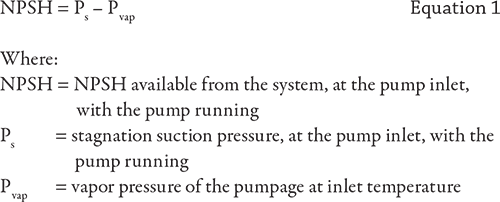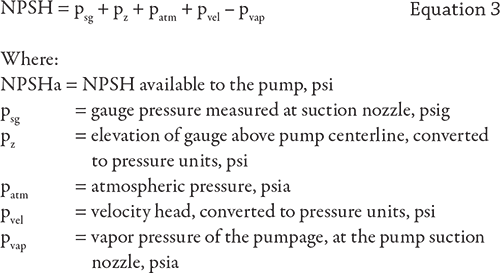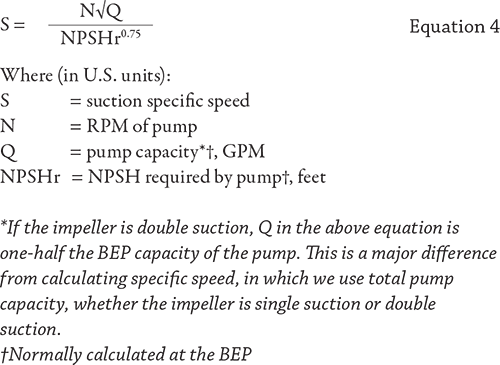Most pump problems are related to net positive suction head.
02/26/2018
Editor’s Note: In 2009 and 2010, Pumps & Systems published a 14-part series of articles by Terry Henshaw called “Understanding NPSH.” Sadly, Henshaw passed away in 2017. We at Pumps & Systems are grateful for his contributions to the education of the rotating equipment industry, especially on a topic as complex as NPSH. The following is a selection from that series.
Definition of NPSH
The margin of pressure over vapor pressure, at the pump suction nozzle, is net positive suction head (NPSH). NPSH is the difference between suction pressure (stagnation) and vapor pressure. In equation form: Since vapor pressure is always expressed on the absolute scale, suction pressure must also be in absolute terms. In U.S. customary units, both pressures must be in pounds per square inch absolute (psia). Gauge pressure is converted to absolute pressure by adding atmospheric pressure.
The above equation provides an answer in units of pressure (psi). This can be converted to units of head (feet) by the following equation:
Since vapor pressure is always expressed on the absolute scale, suction pressure must also be in absolute terms. In U.S. customary units, both pressures must be in pounds per square inch absolute (psia). Gauge pressure is converted to absolute pressure by adding atmospheric pressure.
The above equation provides an answer in units of pressure (psi). This can be converted to units of head (feet) by the following equation:

Importance of NPSH
NPSH is a subject of extreme importance in all pumping systems. It has been estimated that 80 percent of all pump problems are due to inadequate suction conditions, and most suction problems are related to NPSH. (Either the system does not provide as much as anticipated, or the pump requires more than anticipated.) It is therefore probable that most pump problems are NPSH problems.Units of NPSH
For centrifugal pumps, NPSH values are expressed in units of specific energy (equivalent column height) such as feet or meters. For displacement pumps (rotary and reciprocating), NPSH values are normally expressed in pressure units such as pounds per square inch (psi), kilopascals or bars. NPSH values are neither gauge pressures nor absolute pressures. The “g” in psig means that the pressure is measured above atmospheric pressure. The “a” in psia means that the pressure is measured above absolute zero, a perfect vacuum. NPSH is a measurement of pressure above vapor pressure, so the units of NPSH (in the U.S.) are just psi or feet.NPSH Available: A System Characteristic
NPSHa stands for NPSH available from the system. It can be calculated by measuring suction pressure at the pump suction nozzle, correcting to datum, adding atmospheric pressure, adding velocity head and subtracting vapor pressure. In equation form: If desired, all units can be converted to head (feet) prior to plugging into the equation.
If the system has not been built, it is necessary to calculate the NPSHa by starting with the pressure in the suction tank. Add atmospheric pressure, add (or subtract) the liquid level above (below) datum, subtract all losses from the tank to the pump and subtract vapor pressure.
If desired, all units can be converted to head (feet) prior to plugging into the equation.
If the system has not been built, it is necessary to calculate the NPSHa by starting with the pressure in the suction tank. Add atmospheric pressure, add (or subtract) the liquid level above (below) datum, subtract all losses from the tank to the pump and subtract vapor pressure.
NPSH Required: A Pump Characteristic
The letters NPSHr stand for the NPSH required by the pump. This characteristic must be determined by test. For proper operation of the pump, it is necessary that NPSHa > NPSHr. The system must provide more NPSH than the pump requires.What Happens When NPSHr Exceeds NPSHa?
One potential complication when NPSHr exceeds NPSHa is cavitation. If at any time the static pressure on a liquid drops below vapor pressure, a portion of the liquid will boil—it will flash to a gas. This formation of gas bubbles is called cavitation. (Cavities form in the liquid.) Such gas formation in a suction pipe or inside a pump, may cause a reduction in pump capacity and/or head. It may also cause damage to the pump. As liquid flows into any pump, there is a reduction in pressure. In a centrifugal pump, the liquid accelerates into the eye of the impeller, causing a reduction in pressure. The impeller vanes then slice into the liquid, creating zones of lower pressure. If a sufficient pressure margin, over vapor pressure, is not provided at the pump inlet, some of the liquid will flash at the leading edge of each vane. With displacement pumps, the situation is similar. Because the pressure drops as the pumpage moves into the pumping chamber, suction pressure must exceed vapor pressure by some margin to prevent cavitation. Even though the liquid is cavitating, we usually say that the pump is cavitating. Possible effects of pump cavitation include noise, head and/or capacity loss, and equipment damage. It is not the formation of the bubbles that causes damage. Damage is caused to pump parts when the bubbles collapse or “implode.” When the bubbles collapse on a hard surface, they create a high pressure.To Quieten a Cavitating Centrifugal Pump
If a centrifugal pump sounds as if it is pumping gravel, if the system can tolerate it and if no other solution is readily available, inject about ½ percent (by volume) air (or other gas) just upstream (into the inlet) of the pump. Experiment to see how little air is necessary to obtain quiet operation. (Do not try this with a reciprocating pump!)NPSHr & Suction Specific Speed
Suction specific speed, like specific speed, is not a speed at all. It is an index number, or “yardstick.” It is based on the NPSHr of a centrifugal pump, normally the 3 percent head drop NPSHr and normally at its best efficiency point (BEP). The equation for suction specific speed is the same as specific speed, except that NPSHr is substituted for head, as follows: The symbol Nss is often used in place of S for suction specific speed.
The value of S for most pumps is typically between 7,000 and 15,000. The higher values are more common in higher speed, higher capacity units.
The symbol Nss is often used in place of S for suction specific speed.
The value of S for most pumps is typically between 7,000 and 15,000. The higher values are more common in higher speed, higher capacity units.
Suction Specific Speed
For a number of years, the push from users and competitors required pump manufacturers to continually strive for lower values of NPSHr. The philosophy was that “The lower the NPSHr, the better the pump.” NPSHr in centrifugal pumps is normally reduced by increasing the diameter of the impeller eye. That philosophy has now changed. Due to problems that have been attributed to oversized impeller eyes, pump users have established maximum values for S, which establishes minimum values for NPSHr. (See Pumps & Systems, December 2011). Every centrifugal pump would like to run at its BEP. Pump components would experience maximum life at that capacity. Seldom does a pump run at its BEP, but component life will be significantly extended if it operates within its “stable” window of capacities. Suction specific speed can indicate the size of that window. Pumps with lower values of S have larger windows.Ways to Increase NPSHa
If it is necessary to increase a system’s NPSHa, one or more of the following steps may be employed:- Raise the level of the liquid in the suction vessel.
- Cool the liquid (after it leaves the vessel).
- Reduce the losses in the suction line by reducing its length, increasing its diameter, reducing number of fittings, etc.
- Install a booster pump.
- With a reciprocating pump, or pulsating rotary pump, install a bottle or suction stabilizer in the suction line adjacent to the pump.
Ways to Reduce NPSHr
If the pump is in the selection stage, one or more of the following options may be employed to reduce the NPSHr:- Use a double-suction impeller.
- Use a larger pump.
- Use a lower speed pump.
- Use an inducer (a small axial-flow impeller built into the eye of the main impeller).
- Install the pump at a lower elevation.
- With a vertical turbine pump, lower the first-stage impeller (make the pump longer).
- If operating near or beyond the BEP, reduce pump capacity.
- If operating near shut-off, increase pump capacity (with a bypass if necessary).
- Reduce wear ring clearances.
- Reduce seal flush flow.
- Vent the seal chamber (stuffing box) back to the suction vessel.
- On a horizontal multistage pump with a balancing drum, pipe the balancing line back to the suction vessel. The valves in this line must be locked open.
- On a vertical multistage pump, pipe the bleed-off line from the throat bushing back to the suction vessel. The valves in this line should be locked open.

